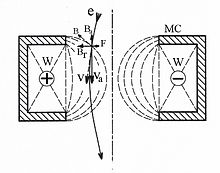NGC 1084
NGC 1084| NGC 1084 | |
|---|---|
 허블우주망원경에 의한 NGC 1084 | |
| 관측 데이터(J2000 epoch) | |
| 별자리 | 에리다누스 |
| 우측 상승 | 02h 45m 59.926s[1] |
| 탈위임 | −07° 34′ 43.10″[1] |
| 레드시프트 | 1,406 km/s[2] |
| 거리 | 62.7 Mly(19.23 Mpc)[2] |
| 겉보기 크기 (V) | 10.7 |
| 특성. | |
| 유형 | SAC[3][4] |
| 겉보기 크기 (V) | 3′.2 × 1′.8[3] |
| 기타 지정 | |
| LEDA 10464, MCG-01-08-007[5] PGC 10464[3] | |
NGC 1084는 에리다누스자리에 있는 비봉선 나선 은하다.그것은 은하수로부터 약 6천 3백만 광년 떨어진 곳에 위치해 있다.이 은하는 윌리엄 허셜에 의해 1785년 1월 10일에 발견되었다.그것은 여러 개의 나선형 팔을 가지고 있는데, 이것은 잘 정의되어 있지 않다.[6]NGC 988, NGC 991, NGC 1022, NGC 1035, NGC 1042, NGC 1047, NGC 1052 및 NGC 1110과 같은 은하군에 속한다.이 그룹은 차례로 메시에 77 그룹과 연관되어 있다.[7]
은하계의 항성 형성은 혼란스럽고 나선팔에 국한되지 않지만, 별 폭발 은하로 분류할 만큼 비율이 높지 않다.별의 형성은 지난 4천만 년 동안 작은 폭발로 일어났다.이 활동의 원인은 가스가 풍부한 왜성 은하와의 합병으로 제시되어 왔다.이 은하에서 남서쪽으로 3.5'의 무선원이 탐지되었고, 이 전파는 다리로 연결되어 있다.[8]NGC 1084는 49년 동안 SN 1963P (매그 14), SN 1996an (타입 II, mag. 14), SN 1998dl (타입 II, mag. 16), SN 2009H (타입 II, mag. 17), SN 2012ec (타입 IIP, 매그 14,5)의 5개의 초신성 폭발의 현장이었다.[9][10]
갤러리
참조
- ^ a b Skrutskie, Michael F.; Cutri, Roc M.; Stiening, Rae; Weinberg, Martin D.; Schneider, Stephen E.; Carpenter, John M.; Beichman, Charles A.; Capps, Richard W.; Chester, Thomas; Elias, Jonathan H.; Huchra, John P.; Liebert, James W.; Lonsdale, Carol J.; Monet, David G.; Price, Stephan; Seitzer, Patrick; Jarrett, Thomas H.; Kirkpatrick, J. Davy; Gizis, John E.; Howard, Elizabeth V.; Evans, Tracey E.; Fowler, John W.; Fullmer, Linda; Hurt, Robert L.; Light, Robert M.; Kopan, Eugene L.; Marsh, Kenneth A.; McCallon, Howard L.; Tam, Robert; Van Dyk, Schuyler D.; Wheelock, Sherry L. (1 February 2006). "The Two Micron All Sky Survey (2MASS)". The Astronomical Journal. 131: 1163–1183. doi:10.1086/498708. ISSN 0004-6256.
- ^ a b Tully, R. Brent; et al. (2016). "Cosmicflows-3". The Astronomical Journal. 152 (2): 21. arXiv:1605.01765. Bibcode:2016AJ....152...50T. doi:10.3847/0004-6256/152/2/50. 50.
- ^ a b c "NASA/IPAC Extragalactic Database". Results for NGC 1084. Retrieved 2016-01-02.
- ^ Ann, H. B.; et al. (2015). "A Catalog of Visually Classified Galaxies in the Local (z ∼ 0.01) Universe". The Astrophysical Journal Supplement Series. 217 (2): 27–49. arXiv:1502.03545. Bibcode:2015ApJS..217...27A. doi:10.1088/0067-0049/217/2/27. S2CID 119253507.
- ^ "NGC 1084". SIMBAD. Centre de données astronomiques de Strasbourg. Retrieved 2020-04-07.
- ^ Eskridge, Paul B.; et al. (November 2002). "Near-Infrared and Optical Morphology of Spiral Galaxies". The Astrophysical Journal Supplement Series. 143 (1): 73–111. arXiv:astro-ph/0206320. Bibcode:2002ApJS..143...73E. doi:10.1086/342340. S2CID 15491635.
- ^ Makarov, Dmitry; Karachentsev, Igor (2011). "Galaxy groups and clouds in the local (z∼ 0.01) Universe". Monthly Notices of the Royal Astronomical Society. 412 (4): 2498–2520. arXiv:1011.6277. Bibcode:2011MNRAS.412.2498M. doi:10.1111/j.1365-2966.2010.18071.x.
- ^ Ramya, S.; et al. (October 2007). "Study of star formation in NGC 1084". Monthly Notices of the Royal Astronomical Society. 381 (2): 511–524. arXiv:0707.2366. Bibcode:2007MNRAS.381..511R. doi:10.1111/j.1365-2966.2007.12232.x.
- ^ "List of Supernovae". IAU Central Bureau for Astronomical Telegrams. Retrieved 29 December 2015.
- ^ "A spiral home to exploding stars". Hubble Space Telescope. 31 March 2014.
외부 링크
 Wikimedia Commons의 NGC 1084 관련 미디어
Wikimedia Commons의 NGC 1084 관련 미디어- NGC 1084 on WikiSky: DSS2, SDSS, GALEX, IRAS, 수소 α, X선, 아스트로포토, 스카이맵, 기사 및 이미지






